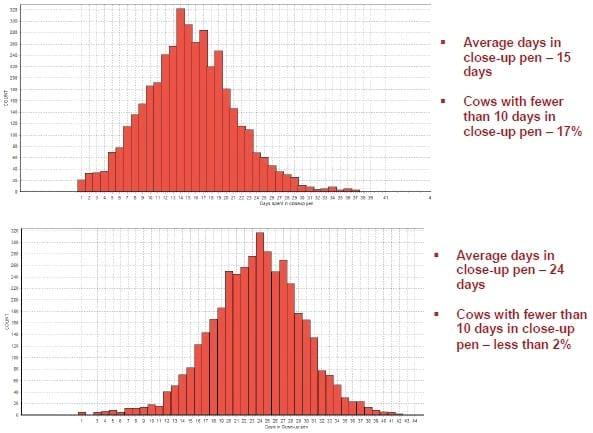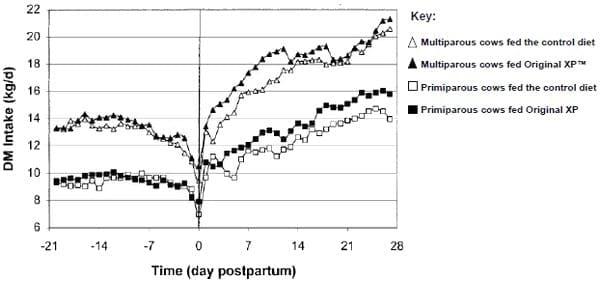Transition cows: Datadriven decisions
Published: December 23, 2015
By: Matt Sattler, Ph.D., Field Technical Specialist, Diamond V.
As technological advancements improve our ability to capture dairy performance data, our ability to manage and interpret that data becomes even more important. This is especially true when it comes to management of the transition cows.
First and foremost, we need to observe and evaluate what the cows are telling us through their performance at both a group and individual level. We can do this on a daily basis via the walkthroughs and work ups of the fresh cows, which gives us a quick “report card” on current performance of the transition cows and immediate needs of the individual cow. Unfortunately, this approach does little to objectively tell us how cows today compare to the same group of cows two weeks or two months ago.
Without an accurate history of what has happened at the dairy, it is nearly impossible to determine whether a management change has had impact, either positive or negative, on performance of the transition cows. However, through the analysis of herd management records specific to performance of the transition cows, we can discover both trends and opportunities. Critical to this evaluation is the availability and accuracy of data points.
Fortunately, with the continued advancement in herd management software programs and EID (electronic identification) technology, the task of recording both group and individual data has become much more efficient, which is especially useful when it comes to assessing disease events.
Leading versus lagging indicators.
To assess performance of the transition cows, keep in mind there are two types of indicators – leading and lagging. While lagging indicators can paint a picture of the success or failure of the transition program, they lack timeliness and specificity to appropriately address performance issues. For example:
- Monitoring change in early lactation milk production (eg. week 4 milk or first test day milk) shows whether we are making progress. However, if negative trends appear, our response to that trend is already too late because we are measuring transition cow performance using an indicator that takes 30-90 days to collect and begin to respond.
- Assessing trends in early lactation turnover (less than 30 days in milk turnover) also faces the “lag effect” problem. In addition to lag, early lactation turnover also lacks specificity to address a particular management concern. If cows leaving the dairy less than 30 days in milk increased from 5% to 9%, then we know there is an issue. But this knowledge doesn’t answer the question “Why did these cows leave?”
In management of transition cows, leading indicators can help predict future trends and are more precise for understanding management opportunities you can address. These leading indicators can include:
Specific changes in transition health events.
Timely, consistent and accurate recording of all transition health events is necessary to monitor performance trends. Without knowing what health events are occurring in the transition cows, it is a challenge to address necessary management changes. One solution is to develop a standard protocol for how health events are defined and recorded in your herd management software program and regularly assess those trends:
- To monitor changes in performance, you need to understand both the cows that were impacted and the population at risk. Accurate interpretation of a numeric increase in health events depends upon the number of cows involved. For example, five displaced abomasums (DA) out of a group of 50 fresh cows is a much more significant concern than five DAs out of a group of 500 fresh cows. Changing herd dynamics can have a big impact in how data is interpreted.
- Health event history also becomes critically important in assessing management changes and whether specific changes achieved the desired impact.
Length of time spent in the close-up pen.
Moves into the close-up pen is a management process that can have direct impact on the success of your transition program. As time spent in the close-up pen declines, you may see increases in transition cow health events and a decline in early lactation milk production.
Instead of managing the outcome (more health events therefore more turnover), you should focus on managing the process of how cows move into the close-up pen (Figure 1). The following questions are important:
- What is your days carried calf (DCC) target for movements to the close-up pen?
- Are there any cows over that DCC target that have not been moved to the close-up pen?
Figure 1. Distribution of days spent in close-up pen at 2 large dairies.

DMI in the close-up and fresh pens.
Maintaining strong feed intakes in transition cows is a key component in supporting health and optimizing dairy performance. Monitoring and addressing changes in DMI in transition diets is critical to a successful transition period.
The graph below (Figure 2) highlights DMI response in early lactation from one of many transition cow studies that investigated the feed intake effects of Diamond V Original Products (Robinson and Garrett, 1999).
Figure 2. Dry matter intake by day relative to parturition for primiparous and multiparous cows.

A large number of such studies supported the unique functional claim reviewed and accepted by the U.S. Food and Drug Administration: “Diamond V Original Product helps support dry matter intake of dairy cows when fed as part of a total mixed ration during the first 70 days of lactation.”
Effective management of the transition period sets the stage for subsequent lactation performance of each and every dairy cow. Understanding performance trends and the ability to evaluate management changes at the optimum time is critical to our ability to give the cow the resources she needs to be successful. Contact your local Diamond V representative to discuss how Diamond V technology can positively impact your management efforts in the transition period.
Related topics:
Authors:
Diamond V
Recommend
Comment
Share

Would you like to discuss another topic? Create a new post to engage with experts in the community.





.jpg&w=3840&q=75)